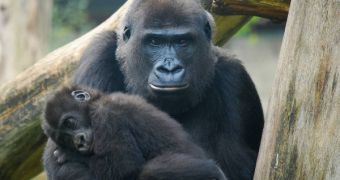A new research, conducted on wild western lowland gorillas in the central parts of Africa, shows that the primates used hand-clapping as a form of communication, something that had only been observed once before. Females employ this type of behavior most often, and they clap to get the attention of both males and infants, and for keeping the group together. Because the animals are so powerful, they can also use this form of communication to stay in touch over long distances, and to coordinate their movements. Details of the finds were published in a recent edition of the scientific journal Primates.
“What struck me most was how it was conducted in such a controlled and deliberate manner while in a bipedal position; much like a human would hand clap. A female was able to exert control over her infant's behavior by hand-clapping. Which did remind me of a human mother,” explained for BBC News Ammie Kalan, a primate expert from the Oxford Brookes University, in Oxford, the UK. Kalan, together with Wildlife Conservation Society (WCS) colleague Hugo Rainey, observed the behavior of gorillas in the Lac Tele Community Reserve Project, located in the Republic of Congo.
The clapping behavior is not news for the researchers. Captive gorillas regularly do this in order to express content at a situation, or even to attract the attention of visitors or attendants, but the role of clapping in the wild has been less analyzed. Kalan said that hand-clapping was identified within four distinct subgroups in the natural reservations, which excludes the possibility of this being just some random adaptation, that a particular group suffered on account of specific environmental conditions.
“It's a form of gestural communication that has largely been overlooked by gorilla researchers. It's used as a form of long distance communication with the silverback, even when humans are not posing an immediate threat, as well as to get the attention of group members. The hand clap allows the gorillas to maintain group cohesiveness,” Kalan added. The expert said that, when a mother gorilla clapped her hands, as the researchers got too close, the infants stopped playing, and the adults from foraging around, and they all followed her gaze towards the human group. After that, the entire group withdrew.

 14 DAY TRIAL //
14 DAY TRIAL //